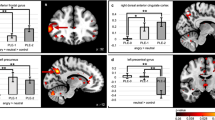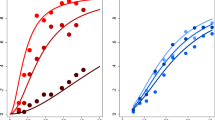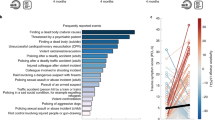Abstract
Early-life trauma is one of the strongest risk factors for later emotional psychopathology. Although research in adults highlights that childhood trauma predicts deficits in emotion regulation that persist decades later, it is unknown whether neural and behavioral changes that may precipitate illness are evident during formative, developmental years. This study examined whether automatic regulation of emotional conflict is perturbed in a high-risk urban sample of trauma-exposed children and adolescents. A total of 14 trauma-exposed and 16 age-, sex-, and IQ-matched comparison youth underwent functional MRI while performing an emotional conflict task that involved categorizing facial affect while ignoring an overlying emotion word. Engagement of the conflict regulation system was evaluated at neural and behavioral levels. Results showed that trauma-exposed youth failed to dampen dorsolateral prefrontal cortex activity and engage amygdala–pregenual cingulate inhibitory circuitry during the regulation of emotional conflict, and were less able to regulate emotional conflict. In addition, trauma-exposed youth showed greater conflict-related amygdala reactivity that was associated with diminished levels of trait reward sensitivity. These data point to a trauma-related deficit in automatic regulation of emotional processing, and increase in sensitivity to emotional conflict in neural systems implicated in threat detection. Aberrant amygdala response to emotional conflict was related to diminished reward sensitivity that is emerging as a critical stress-susceptibility trait that may contribute to the emergence of mental illness during adolescence. These results suggest that deficits in conflict regulation for emotional material may underlie heightened risk for psychopathology in individuals that endure early-life trauma.
Similar content being viewed by others
Log in or create a free account to read this content
Gain free access to this article, as well as selected content from this journal and more on nature.com
or
References
Angold A, Costello EJ, Worthman CM (1998). Puberty and depression: the roles of age, pubertal status and pubertal timing. Psychol Med 28: 51–61.
Birmaher B, Khetarpal S, Brent D, Cully M, Balach L, Kaufman J et al (1997). The Screen for Child Anxiety Related Emotional Disorders (SCARED): scale construction and psychometric characteristics. J Am Acad Child Adolesc Psychiatry 36: 545–553.
Bogdan R, Nikolova YS, Pizzagalli DA (2013). Neurogenetics of depression: a focus on reward processing and stress sensitivity. Neurobiol Dis 52: 12–23.
Bogdan R, Pizzagalli DA (2006). Acute stress reduces reward responsiveness: implications for depression. Biol Psychiatry 60: 1147–1154.
Botvinick M, Nystrom LE, Fissell K, Carter CS, Cohen JD (1999). Conflict monitoring versus selection-for-action in anterior cingulate cortex. Nature 402: 179–181.
Botvinick MM, Braver TS, Barch DM, Carter CS, Cohen JD (2001). Conflict monitoring and cognitive control. Psychol Rev 108: 624–652.
Carver CS, White TL (1994). Behavioral inhibition, behavioral activation, and affective responses to impending reward and punishment: the BIS/BAS Scales. J Pers Soc Psychol 67: 319–333.
Casey BJ, Trainor RJ, Orendi JL, Schubert AB, Nystrom LE, Giedd JN et al (1997). A developmental functional MRI study of prefrontal activation during performance of a go-no-go task. J Cogn Neurosci 9: 835–847.
Derrfuss J, Brass M, Neumann J, von Cramon DY (2005). Involvement of the inferior frontal junction in cognitive control: meta-analyses of switching and Stroop studies. Hum Brain Mapp 25: 22–34.
Egger HL, Pine DS, Nelson E, Leibenluft E, Ernst M, Towbin KE et al (2011). The NIMH Child Emotional Faces Picture Set (NIMH-ChEFS): a new set of children's facial emotion stimuli. Int J Methods Psychiatric Res 20: 145–156.
Egner T, Etkin A, Gale S, Hirsch J (2008). Dissociable neural systems resolve conflict from emotional versus nonemotional distracters. Cereb Cortex 18: 1475–1484.
Etkin A, Egner T, Peraza DM, Kandel ER, Hirsch J (2006). Resolving emotional conflict: a role for the rostral anterior cingulate cortex in modulating activity in the amygdala. Neuron 51: 871–882.
Etkin A, Prater KE, Hoeft F, Menon V, Schatzberg AF (2010). Failure of anterior cingulate activation and connectivity with the amygdala during implicit regulation of emotional processing in generalized anxiety disorder. Am J Psychiatry 167: 545–554.
Etkin A, Schatzberg AF (2011). Common abnormalities and disorder-specific compensation during implicit regulation of emotional processing in generalized anxiety and major depressive disorders. Am J Psychiatry 168: 968–978.
Etkin A, Wager TD (2007). Functional neuroimaging of anxiety: a meta-analysis of emotional processing in PTSD, social anxiety disorder, and specific phobia. Am J Psychiatry 164: 1476–1488.
Fair DA, Nigg JT, Iyer S, Bathula D, Mills KL, Dosenbach NU et al (2012). Distinct neural signatures detected for ADHD subtypes after controlling for micro-movements in resting state functional connectivity MRI data. Front Syst Neurosci 6: 80.
Forbes EE, Hariri AR, Martin SL, Silk JS, Moyles DL, Fisher PM et al (2009). Altered striatal activation predicting real-world positive affect in adolescent major depressive disorder. Am J Psychiatry 166: 64–73.
Ford JDP (2005). Treatment implications of altered affect regulation and information processing following child maltreatment. Psychiatr Ann 35: 410–419.
Friston KJ, Buechel C, Fink GR, Morris J, Rolls E, Dolan RJ (1997). Psychophysiological and modulatory interactions in neuroimaging. NeuroImage 6: 218–229.
Garner KG, Dux PE, Wagner J, Cummins TD, Chambers CD, Bellgrove MA (2012). Attentional asymmetries in a visual orienting task are related to temperament. Cogn Emot 26: 1508–1515.
Gee DG, Gabard-Durnam LJ, Flannery J, Goff B, Humphreys KL, Telzer EH et al (2013). Early developmental emergence of human amygdala-prefrontal connectivity after maternal deprivation. Proc Natl Acad Sci USA 110: 15638–15643.
Gilbert R, Widom CS, Browne K, Fergusson D, Webb E, Janson S (2009). Burden and consequences of child maltreatment in high-income countries. Lancet 373: 68–81.
Hare TA, Tottenham N, Galvan A, Voss HU, Glover GH, Casey BJ (2008). Biological substrates of emotional reactivity and regulation in adolescence during an emotional go-nogo task. Biol Psychiatry 63: 927–934.
Hayes AF (2013) Introduction to Mediation, Moderation, and Conditional Process Analysis: A Regression-Based Approach. Guilford Publications.
Kasch KL, Rottenberg J, Arnow BA, Gotlib IH (2002). Behavioral activation and inhibition systems and the severity and course of depression. J Abnorm Psychol 111: 589–597.
Kaufman AS, Kaufman NL (2004) Kaufman Brief Intelligence Test-Second Edition (KBIT-2). American Guidance Service: Circle Pines, MN.
Kaufman J, Plotsky PM, Nemeroff CB, Charney DS (2000). Effects of early adverse experiences on brain structure and function: clinical implications. Biol Psychiatry 48: 778–790.
Kovacs M (1985). The Children’s Depression, Inventory (CDI). Psychopharmacol Bull 21: 995–998.
LeDoux JE (1996) The Emotional Brain: The Mysterious Underpinnings of Emotional Life. Simon & Schuster.
Lieberman MD, Cunningham WA (2009). Type I and type II error concerns in fMRI research: re-balancing the scale. Soci Cogn Affect Neurosci 4: 423–428.
Maier ME, di Pellegrino G (2012). Impaired conflict adaptation in an emotional task context following rostral anterior cingulate cortex lesions in humans. J Cogn Neurosci 24: 2070–2079.
Marusak HA, Carre JM, Thomason ME (2013). The stimuli drive the response: an fMRI study of youth processing adult or child emotional face stimuli. NeuroImage 83: 679–689.
McCrory EJ, De Brito SA, Sebastian CL, Mechelli A, Bird G, Kelly PA et al (2011). Heightened neural reactivity to threat in child victims of family violence. Curr Biol 21: R947–R948.
McMakin DL, Olino TM, Porta G, Dietz LJ, Emslie G, Clarke G et al (2012). Anhedonia predicts poorer recovery among youth with selective serotonin reuptake inhibitor treatment-resistant depression. J Am Acad Child Adolesc Psychiatry 51: 404–411.
Morgan JK, Olino TM, McMakin DL, Ryan ND, Forbes EE (2013). Neural response to reward as a predictor of increases in depressive symptoms in adolescence. Neurobiol Dis 52: 66–74.
Ochsner KN, Gross JJ (2005). The cognitive control of emotion. Trends Cogn Sci 9: 242–249.
Patenaude B, Smith SM, Kennedy DN, Jenkinson M (2011). A Bayesian model of shape and appearance for subcortical brain segmentation. NeuroImage 56: 907–922.
Pechtel P, Pizzagalli DA (2011). Effects of early life stress on cognitive and affective function: an integrated review of human literature. Psychopharmacology 214: 55–70.
Pollak SD (2008). Mechanisms linking early experience and the emergence of emotions: illustrations from the study of maltreated children. Curr Dir Psychol Sci 17: 370–375.
Thomason ME, Tocco MA, Quednau KA, Bedway AR, Carre JM (2013). Idle behaviors of the hippocampus reflect endogenous cortisol levels in youth. J Am Acad Child Adolesc Psychiatry 52: 642–652 e641.
Tottenham N, Hare TA, Quinn BT, McCarry TW, Nurse M, Gilhooly T et al (2010). Prolonged institutional rearing is associated with atypically large amygdala volume and difficulties in emotion regulation. Dev Sci 13: 46–61.
Treadway MT, Zald DH (2011). Reconsidering anhedonia in depression: lessons from translational neuroscience. Neurosci Biobehav Rev 35: 537–555.
Vuilleumier P, Armony JL, Driver J, Dolan RJ (2001). Effects of attention and emotion on face processing in the human brain: an event-related fMRI study. Neuron 30: 829–841.
Whalen P (1998). Fear, vigilance, and ambiguity: initial neuroimaging studies of the human amygdala. Curr Dir Psychol Sci 7: 177–188.
Acknowledgements
We thank Zahid Latif and Yashwanth Katkuri of Wayne State University (WSU) for their assistance in neuroimaging data acquisition, Kayla Martin, Gregory H. Baldwin, Melissa Youmans, Mallory Gardner, Amy Katherine Swartz, Timothy Lozon, Berta Rihan, Stephen Shen, Amy Anderson, and Ali Daher of WSU for assistance in participant recruitment and data collection, Luke Hyde, Arianna Gard, and Megan Martz for feedback on writing, and children and their families who participated in this research. Research reported in this publication was supported, in part, by the Merrill Palmer Skillman Institute and the Department of Pediatrics, Wayne State University School of Medicine, by a NARSAD Young Investigator Award to MET. AE was supported by the Sierra-Pacific MIRECC at the VA Palo Alto Health Care System.
Author information
Authors and Affiliations
Corresponding author
Additional information
Supplementary Information accompanies the paper on the Neuropsychopharmacology website
Supplementary information
Rights and permissions
About this article
Cite this article
Marusak, H., Martin, K., Etkin, A. et al. Childhood Trauma Exposure Disrupts the Automatic Regulation of Emotional Processing. Neuropsychopharmacol 40, 1250–1258 (2015). https://doi.org/10.1038/npp.2014.311
Received:
Revised:
Accepted:
Published:
Issue date:
DOI: https://doi.org/10.1038/npp.2014.311
This article is cited by
-
From early relational experiences to non-suicidal self-injury in anorexia and bulimia nervosa: a structural equation model unraveling the role of impairments in interoception
Eating and Weight Disorders - Studies on Anorexia, Bulimia and Obesity (2024)
-
Unconscious cognitive reappraisal and unconscious expression suppression regulate emotional responses: an ERP study
Current Psychology (2024)
-
The Queensland Twin Adolescent Brain Project, a longitudinal study of adolescent brain development
Scientific Data (2023)
-
The NIH childhood adversity portfolio: unmet needs, emerging challenges
Pediatric Research (2023)
-
Alexithymia and depressive symptoms mediated the relationship between childhood trauma and suicidal risk in Chinese male prisoners
Current Psychology (2023)



